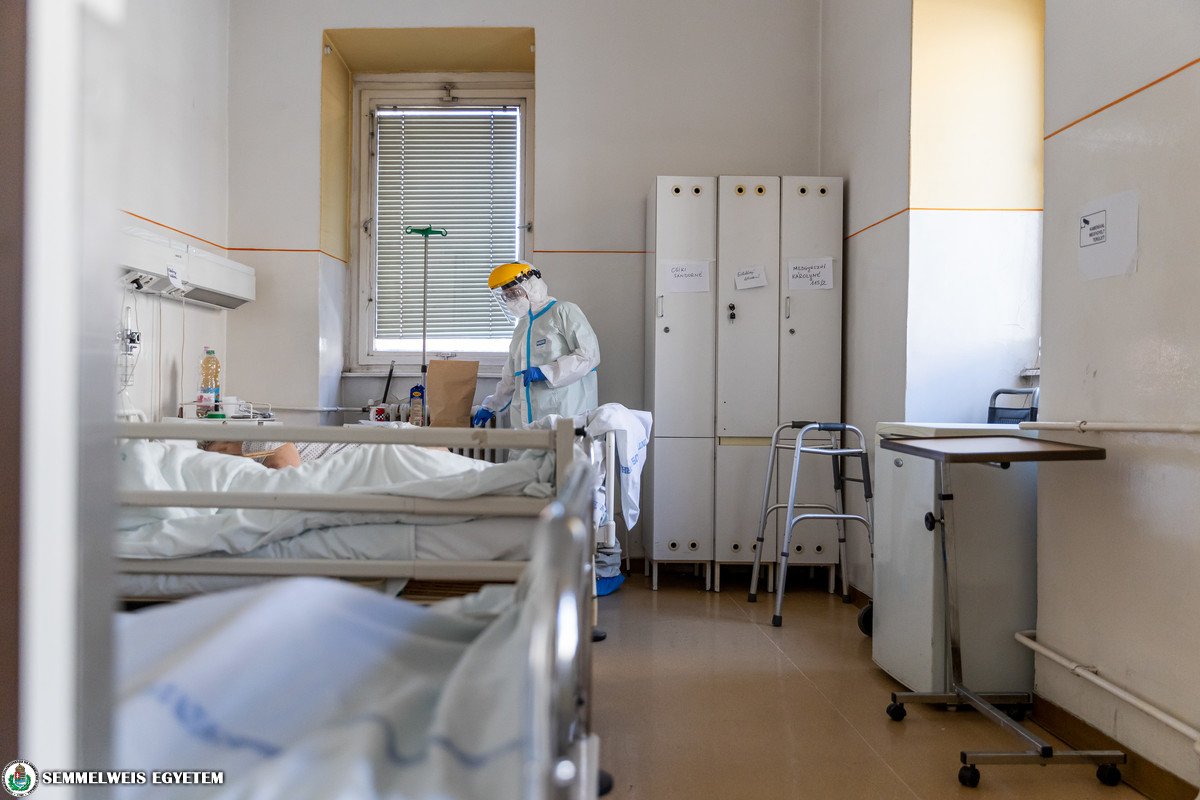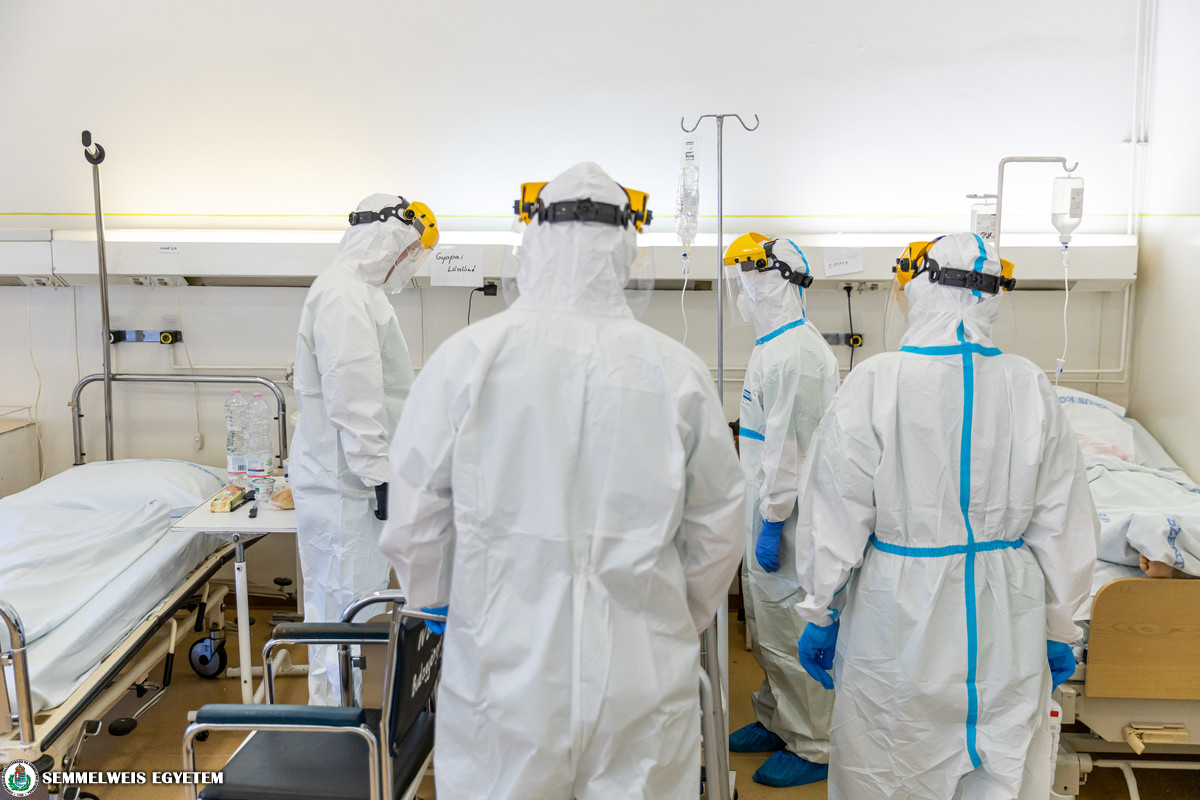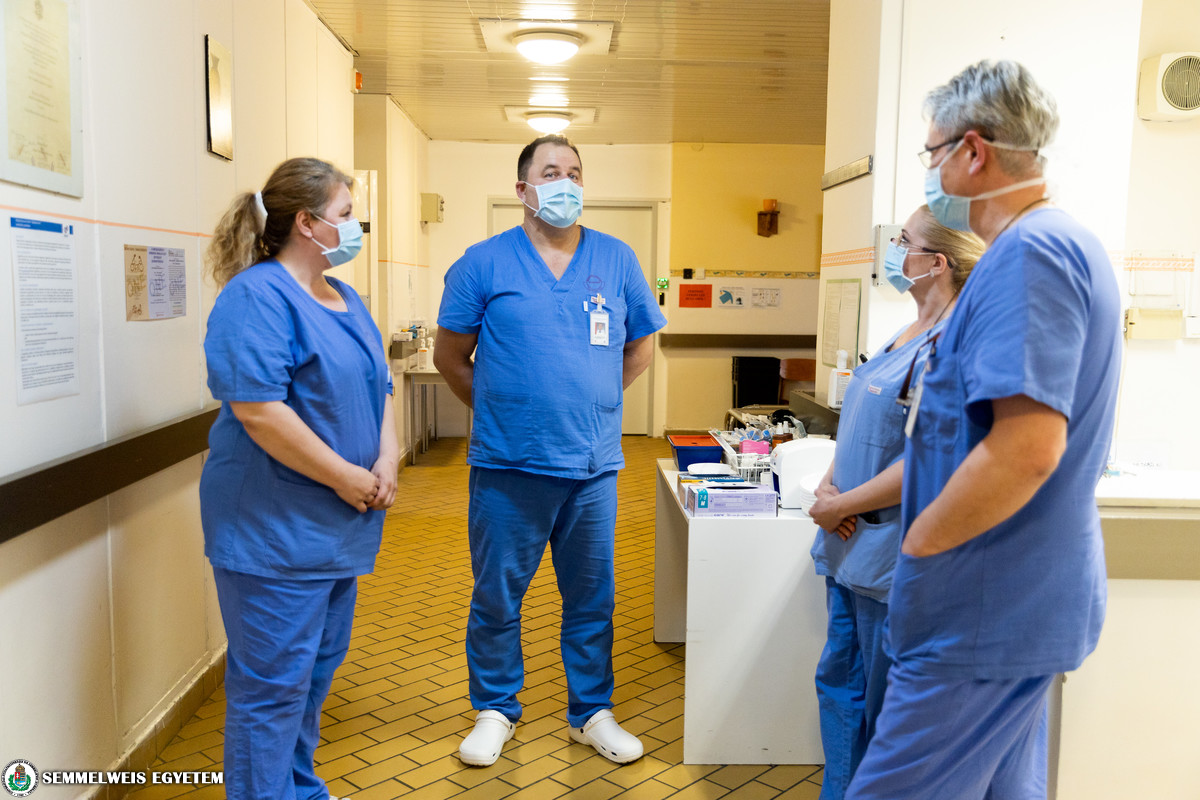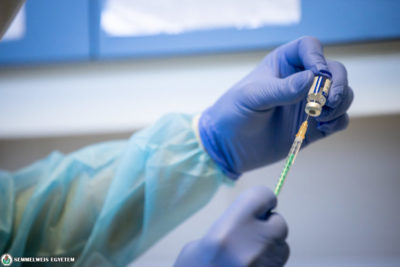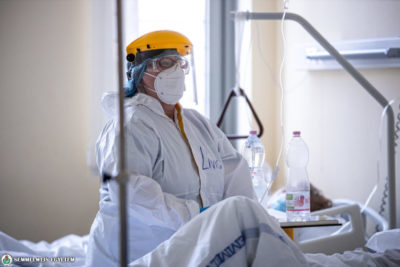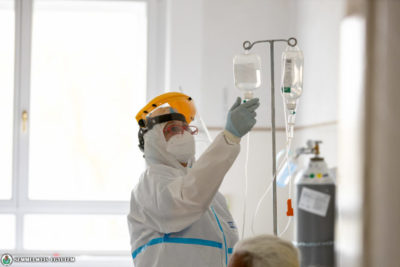Three departments of Semmelweis University’s Szent Rókus Clinical Block are involved in COVID patient care: the Geriatrics Clinic and the Center of Nursing Sciences, as well as its cardiac and musculoskeletal rehabilitation departments. Coronavirus patients not requiring intensive therapy have been treated in this clinical block. In addition, one of the university’s vaccination centers also operates here. Dr. Zsolt Göböl, Director-General, Rector’s Commissioner; Dr. Péter Somogyi, Department Head; as well as the head nurses of the three departments involved in the care of coronavirus patients, Andrea Virág, Noémi Kocsisné Nyakas and Tibor Mészáros were asked about their experiences of COVID-care. At the peak of the epidemic, more than 100 coronavirus patients were treated in this clinical block. As the epidemic subsides, the number of patients have decreased by 90% by the beginning of May.
“It was heart warming to see how rapidly everyone found their place”
Dr. Zsolt Göböl, Director-General, Rector’s Commissioner
How long has Szent Rókus Clinical Block been involved in COVID care? Do you remember the first case?
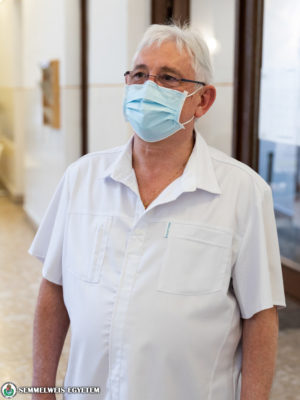 Szent Rókus Hospital became part of Semmelweis University on 1 June 2020 and patient care is fundamentally determined by the fact that it focuses on nursing and rehabilitation with no intensive care unit (more details about the block can be found in the framed section at the end of the article). During the first wave, in the spring of 2020, the integration process had already started, therefore cooperation with the university also started in connection with the epidemic. The first case is particularly memorable for us: about a month after the outbreak of the epidemic in Hungary, one of our chronic patients had a positive COVID test. With the quick and effective help of the university leaders and specialists, we prevented the spread of the infection, which would have been a serious threat, given the condition and age of our inpatients. University staff screened all of our patients and hospital staff. Fortunately we found only a few infected patients, who were isolated at the COVID department set up at the musculoskeletal rehabilitation unit. More severe cases were transferred to the Department of Pulmonology.
Szent Rókus Hospital became part of Semmelweis University on 1 June 2020 and patient care is fundamentally determined by the fact that it focuses on nursing and rehabilitation with no intensive care unit (more details about the block can be found in the framed section at the end of the article). During the first wave, in the spring of 2020, the integration process had already started, therefore cooperation with the university also started in connection with the epidemic. The first case is particularly memorable for us: about a month after the outbreak of the epidemic in Hungary, one of our chronic patients had a positive COVID test. With the quick and effective help of the university leaders and specialists, we prevented the spread of the infection, which would have been a serious threat, given the condition and age of our inpatients. University staff screened all of our patients and hospital staff. Fortunately we found only a few infected patients, who were isolated at the COVID department set up at the musculoskeletal rehabilitation unit. More severe cases were transferred to the Department of Pulmonology.
What is the role of your unit in the care of COVID-19 patients, and how has this changed during the different waves of the epidemic?
We had very similar tasks during the first and second waves. In the spring of 2020, we took part in the fight against the epidemic by setting up quarantine for university staff at the musculoskeletal rehabilitation department. We provided space for university employees with a positive COVID test result, who were not in need of hospital care but did not have the opportunity to be quarantined in their home. In addition, Szent Rókus Hospital took over those patients from university departments who had recovered from COVID-19, but still needed hospital care because of their underlying disease. Due to the increasing number of cases during the third wave, a COVID unit was set up at our departments as well. First, the 30 beds at the Geriatrics Clinic and the Center of Nursing Sciences were transformed into COVID wards, then the cardiac rehabilitation unit joined in with 30 beds, and the musculoskeletal unit provided a capacity of 33 beds. Patients continued to be transferred to us from other university departments, and due to our nursing-rehabilitation profile, those patients were admitted by us who did not require intensive therapy. At the same time, we continued chronic and nursing care throughout the pandemic, as our patients require uninterrupted hospital care.
To what extent did you have to reorganize your work?
We reorganized the life of the entire building, all our staff have taken part in COVID care and in vaccination. We adjusted the schedule of the staff to the needs and tasks. Overnight surgery, for example, has been kept to a minimum during the pandemic, therefore almost all employees working in this area have been involved in the work of the COVID departments and the vaccination center, opened in mid-January. Providing support was also important at the vaccination centers, as we administer more than two thousand vaccines a day (the number of shots given the day after the interview exceeded 3,600). It was great to see how rapidly everyone found their place and how staff from different departments made a good team.
What are the most important lessons and experiences that will be useful in the future?
The epidemic became a beautiful example of in-house collaboration and with other university departments as well. I would say, the integration of the hospital in the university is absolutely positive. Our staff has demonstrated the power of teamwork and that patients are the most important to them.
COVID patient care through the eyes of a department head
 The department heads of the three units of the block involved in COVID patient care are Dr. Klára Gadó (Geriatrics Clinic and Center for Nursing Sciences), Dr. András Papp (cardiac rehabilitation department) and Dr. Péter Somogyi (musculoskeletal rehabilitation department). Dr. Péter Somogyi highlighted the role of the university’s background support.
The department heads of the three units of the block involved in COVID patient care are Dr. Klára Gadó (Geriatrics Clinic and Center for Nursing Sciences), Dr. András Papp (cardiac rehabilitation department) and Dr. Péter Somogyi (musculoskeletal rehabilitation department). Dr. Péter Somogyi highlighted the role of the university’s background support.
“There has never been a shortage of protective equipment and medicine. The university provided a regular supply of these tools that are also important for patient safety. Physicians from university departments came to help us several times, and our specialists were assigned to in-house according to the tasks. An excellent team was made, the employees entered the red zone with no reluctance and took their part in the fight against the epidemic”, said Dr. Péter Somogyi.
He also emphasized the role of nurses who spent most of their time in the front line. Dr. Péter Somogyi also pointed out that since the units in Szent Rókus Hospital are located in a close proximity to each other within the building, they were able to rapidly adapt to the current situation. When it was necessary, the Director-General and the department heads were able to have a quick consultation and tailor care according to the needs.
Andrea Virág, Head Nurse at the Geriatrics Clinic and Centre for Nursing Sciences:
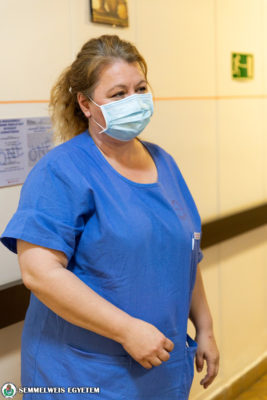 “At the peak of the second wave of the epidemic, coronavirus patients were cared for on 60 beds in the red zone and on 40 beds in the intermediary zone. Then in February 2021, the cardiac rehabilitation department took over the operation of 30 red-zone beds and later, the musculoskeletal rehabilitation department joined in. COVID patient care was an entirely new situation and challenge for all of us; we also came across wearing protective equipment for the first time, so we had to learn how to use it appropriately, safely, and how to put it on. Anyone who enters the red zone spends 3-4 hours indoors in full protective gear, which causes a number of inconveniences, but it is not easy to find the vein of a patient in multi-layered rubber gloves, either. When organizing work, we tried to group activities based on the time they required and the order of their sequence. At the same time, patient care and nursing were not significantly different from our usual work, as we are prepared for the treatment of elderly patients with weakened condition. I would highlight that nurses from different departments found common ground very easily. When COVID care started at our department, nurses and operating room nurses of the Department of Minimally Invasive and One-Day Surgery and Outpatient Clinic joined us to help, who became a member of the team in an instant.”
“At the peak of the second wave of the epidemic, coronavirus patients were cared for on 60 beds in the red zone and on 40 beds in the intermediary zone. Then in February 2021, the cardiac rehabilitation department took over the operation of 30 red-zone beds and later, the musculoskeletal rehabilitation department joined in. COVID patient care was an entirely new situation and challenge for all of us; we also came across wearing protective equipment for the first time, so we had to learn how to use it appropriately, safely, and how to put it on. Anyone who enters the red zone spends 3-4 hours indoors in full protective gear, which causes a number of inconveniences, but it is not easy to find the vein of a patient in multi-layered rubber gloves, either. When organizing work, we tried to group activities based on the time they required and the order of their sequence. At the same time, patient care and nursing were not significantly different from our usual work, as we are prepared for the treatment of elderly patients with weakened condition. I would highlight that nurses from different departments found common ground very easily. When COVID care started at our department, nurses and operating room nurses of the Department of Minimally Invasive and One-Day Surgery and Outpatient Clinic joined us to help, who became a member of the team in an instant.”
Noémi Kocsisné Nyakas, Head Nurse of the cardiac rehabilitation department affiliated to the Heart and Vascular Center:
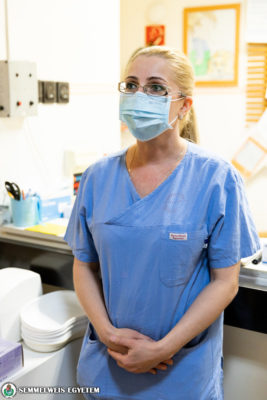 “We deal with the rehabilitation of patients of 40-50 years who have had infarction, therefore, our participation in COVID care has enabled us to care for patients with weakened conditions. We had to treat patients who were much older and in worse condition than those who we usually treat. Therefore, the nursing tasks and meeting the basic needs of the patients were given more emphasis. It was a great feeling to see that the nurses were able to adapt to the new work processes in no time. The physiotherapists and masseurs were also involved in patient care and they also entered the red zone if its was necessary. On one of the two floors belonging to our department, we set up a 30-bed COVID ward that was continuously operating at full capacity at the peak of the epidemic. This challenge has helped staff to work as a team, as we had to know what our colleagues needed simply by looking at them.”
“We deal with the rehabilitation of patients of 40-50 years who have had infarction, therefore, our participation in COVID care has enabled us to care for patients with weakened conditions. We had to treat patients who were much older and in worse condition than those who we usually treat. Therefore, the nursing tasks and meeting the basic needs of the patients were given more emphasis. It was a great feeling to see that the nurses were able to adapt to the new work processes in no time. The physiotherapists and masseurs were also involved in patient care and they also entered the red zone if its was necessary. On one of the two floors belonging to our department, we set up a 30-bed COVID ward that was continuously operating at full capacity at the peak of the epidemic. This challenge has helped staff to work as a team, as we had to know what our colleagues needed simply by looking at them.”
Tibor Mészáros, Head Nurse of the musculoskeletal rehabilitation department affiliated to the Department of Orthopedic Surgery:
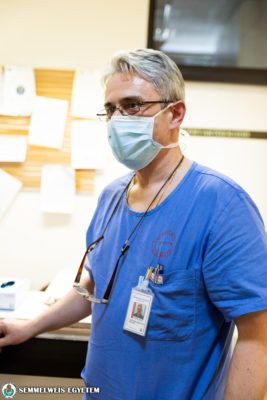 “During the first wave, only our department operated as a COVID unit within the clinical block. In the third wave, we joined COVID patient care again by operating a 32-bed department. We also set up an additional unit of 21 beds, but as the epidemic subsided, this no longer had to be used. The life of the department was completely changed by the fight against the epidemic. In the beginning, we had a few days to hold trainings on the use of protective equipment and to create the appropriate background in the meantime. We organized work in a way to make our nurses spend as little time in the red zone as possible. For example, we rearranged the storage of infusions and oxygen so that nurses needed as little time as possible to access them. Together with the senior nurses of the other departments, we have created a number of guidelines and procedures based on international, national and university guidelines. The guidelines related to various activities (e.g. antibiotics, administering blood thinners) were displayed at several points of the department so that they are always at hand in emergency care environments such as the red zone, where patient documentation cannot be brought inside. For me, the positive lesson of the epidemic is that we were able to work together as a team including healthcare professionals, like physiotherapists sometimes also performed auxiliary nursing tasks without hesitation in order to provide the highest level of care for the patients. ”
“During the first wave, only our department operated as a COVID unit within the clinical block. In the third wave, we joined COVID patient care again by operating a 32-bed department. We also set up an additional unit of 21 beds, but as the epidemic subsided, this no longer had to be used. The life of the department was completely changed by the fight against the epidemic. In the beginning, we had a few days to hold trainings on the use of protective equipment and to create the appropriate background in the meantime. We organized work in a way to make our nurses spend as little time in the red zone as possible. For example, we rearranged the storage of infusions and oxygen so that nurses needed as little time as possible to access them. Together with the senior nurses of the other departments, we have created a number of guidelines and procedures based on international, national and university guidelines. The guidelines related to various activities (e.g. antibiotics, administering blood thinners) were displayed at several points of the department so that they are always at hand in emergency care environments such as the red zone, where patient documentation cannot be brought inside. For me, the positive lesson of the epidemic is that we were able to work together as a team including healthcare professionals, like physiotherapists sometimes also performed auxiliary nursing tasks without hesitation in order to provide the highest level of care for the patients. ”
Szent Rókus Clinical Block
223-year-old Szent Rókus Hospital, the former workplace of Ignác Semmelweis, is the second oldest hospital in Europe and still provides healthcare services today. The institution has had a nursing and rehabilitation profile since 1 April, 2007: active care was excluded from its profile and services related to cardiac rehabilitation, gastroenterological rehabilitation, musculoskeletal rehabilitation, and the largest multidisciplinary one-day surgery in the country were established, retaining the wide range of diagnostic departments and clinics. As of 1 June, 2020 the hospital operates as Semmelweis University’s Szent Rókus Clinical Block. There are two independent departments within the block: the Geriatrics Clinic and Center for Nursing Sciences, as well as the Department of Minimally Invasive and One-Day Surgery and Outpatient Clinic. The other units, such as the rehabilitation departments, function as part of various other departments of Semmelweis University.
Pálma Dobozi
Photo: Attila Kovács – Semmelweis University
Translation: Katalin Illés-Romhányi
